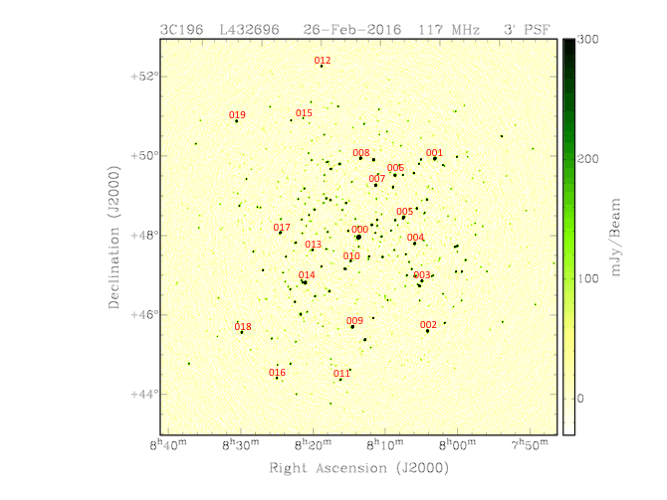Daily Image
04-11-2016Very-wide-field VLBI-imaging with LOFAR
| Submitter: | Ger de Bruyn |
| Description: | It is well-known that LOFAR can image large areas of the sky. However, it is less known that this can be done at any resolution, up to the 0.25" PSF provided by the full European scale LOFAR in the HBA band. And this can be done using standard LOFAR tools! This animation cycles through a selection of 10 images of bright (1-10Jy) sources around the quasar 3C196, which is located in the middle of the image and marked as (SAP)000 (SAP is LOFAR jargon for Sub Array Pointing). The resolution in each VLBI image is about 700 times that of the overview panel which returns with a different objects at 3s intervals. Many of the radio sources exhibit the morphology of extragalactic double radio sources. Some show interesting complex structure (e.g. SAP007, 013) and some are barely resolved (e.g. SAP003, 015). The brightest compact sources can be used to transfer calibration solutions to even larger distance, "hopping" from one field to the next. The wonders of multi-beaming! I estimate that at least several hundred high resolution images can be extracted from a single 8h synthesis LOFAR observation. To display the full field of view at 0.25 arcsec resolution however, requires about 360,000 x 360,000 pixels of 0.1 x 0.1 arcsec. This adds up to 130 billion pixels, the equivalent of more than 16,000 4k x 2k monitors!! You want more technical details? Read on. Data: The data were taken as part of the LOFAR EoR project on 26 Feb 2016 with the aim to construct high resolution images for calibration. A record total of 74 stations participated: 12 IS, 14 RS and 48 CS; the observation lasted 8 hours. Digital beams were generated towards 20 bright sources in a 10x10 degrees area surrounding 3C196. For each pointing 4 groups of 6 contiguous 0.2 MHz subbands, centered around 116, 136, 156 and 171 MHz were correlated, each with 64ch/sb and 1 s time resolution. Calibration: Following the transfer of (self)calibration solutions for 3C196 to all other pointings, even those as far away as 4 degrees (like SAP012 and SAP016), each source could be self calibrated. I used an iterative scheme where the baseline range for calibration and imaging was slowly increased from 50 klambda to 900 klambda. In each iteration I used NDPPP to calibrate and WSClean to image and deconvolve. Some sources had only a peak flux of 30 mJy at the highest resolution. Depending on the time and frequency resolution of the data one can image an area of at least 1 degree diameter around every pointing, which means that basically the whole 10x10 degree field can be imaged at 0.25" resolution if you make an intelligent choice of sub array pointings and have plenty of disk space. Imaging: Note that the images have different scales and also saturate at different intensities (normally the peak intensity) which can be read off from the colour bar on the right. Typical off-source noise levels, in just 1.1 MHz of bandwidth (6 subbands), vary between 0.5 and 1.5 mJy depending on the peak brightness of the source; the dynamic range goes up to a few 1000:1 on the brightest sources. Most images refer to 171 MHz which of course has the highest resolution. |
| Copyright: | Ger de Bruyn |
| Tweet |  |
